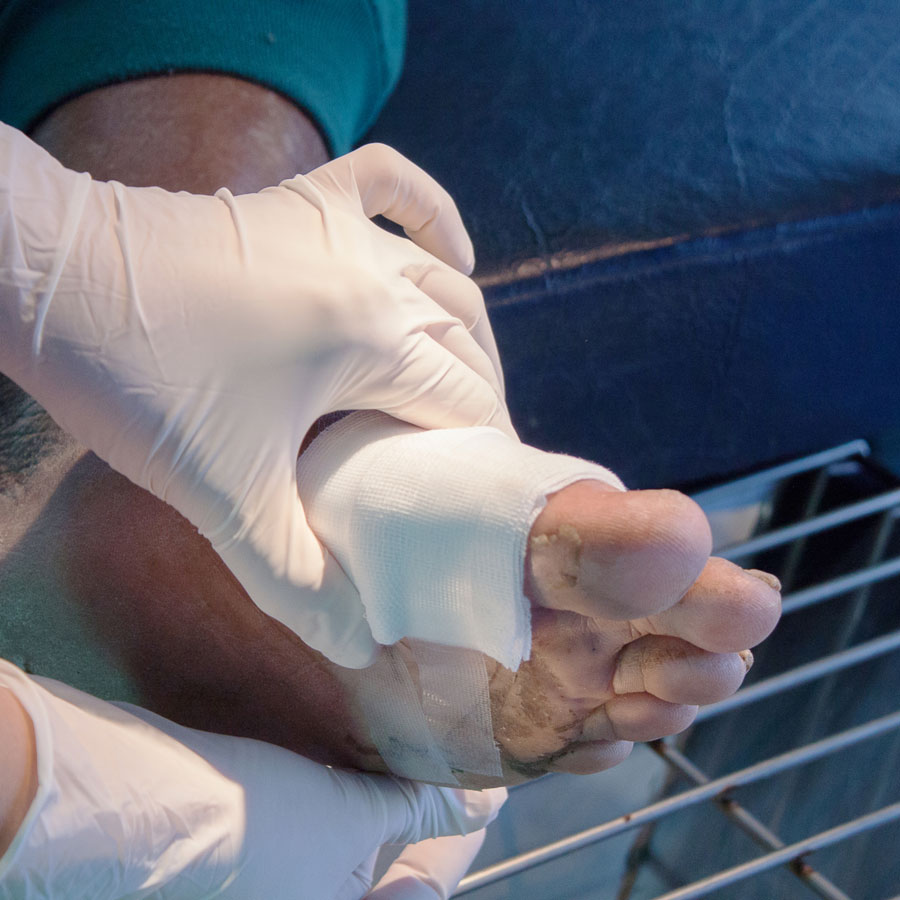For diabetics, foot care is not a luxury but a way to prevent serious medical complications. One of the most life-threatening and unfortunately common conditions is the development of diabetic foot ulcers. These open sores or wounds can start out small but can become limb-threatening if not properly addressed.
Let’s get a better understanding of what leads to diabetic foot ulcers, how they are treated, and the best ways to prevent them.
What Are Diabetic Foot Ulcers?
A diabetic foot ulcer is an open sore or wound that typically occurs on the bottom of the foot. Foot ulcers occur in approximately 15% of people with diabetes and are a frequent cause of hospitalization for those with diabetes, according to the CDC and the American Diabetes Association.
Ulcers most commonly start due to a combination of neuropathy (nerve damage) and poor circulation, both common diabetes complications. If there’s less feeling, an individual may not feel an injury or irritation. If the circulation is poor too, the body can’t effectively heal the wound, and an ulcer forms.
If not treated, ulcers will become progressively deeper, infected, and can have serious results like amputation or systemic infection.

Causes and Risk Factors
The key causes and risk factors for diabetic foot ulcers are:
- Peripheral neuropathy – Loss of protective sensation of the feet
- Impaired circulation – Peripheral arterial disease reduces oxygenation of the tissues
- Foot deformities – Hammertoes, bunions, or bony prominences generate pressure sores
- Poor shoes – Restrictive footwear that rubs and wears away the skin
- Inadequate glycemic control – Elevated blood glucose impairs immune function and healing
- Past history of amputation or ulcer – Recurrent frequency without protective treatment
- Smoking – Further slows circulation and heals slowly
How Diabetic Foot Ulcers Are Diagnosed
At medical facilities like Vale Foot and Ankle, where both medical and surgical care for the foot is provided, diagnosis typically includes:
- Visual examination of the wound
- Measurement of the depth and location of the wound
- Reading for infection
- Imaging studies, including X-rays or ultrasound, to assess whether bone is involved (osteomyelitis)
- Vascular assessment to assess circulation
- Wound culture in suspected infection
Early diagnosis is essential. Delay can lead to deep tissue disease or systemic compromise.

Managing Diabetic Foot Ulcers: Treatment
Non-Surgical Wound Treatment
The goals of ulcer management are healing of the ulcer, prevention of infection, and elimination of pressure from the wound. Non-surgical management may involve:
- Debridement – removal of dead or infected tissue
- Offloading devices – custom orthoses, walking boots, or special shoes that offload
- Moist wound dressing – helps with an optimal healing environment
- Topical or oral antibiotics – If infection occurs
- Advanced treatment – such as bioengineered skin graft, negative pressure wound therapy (wound vac), or growth factors
- Control of blood glucose – A very crucial requirement for successful wound healing
Surgical Intervention
When ulcers fail to heal or become infected, surgery is sometimes necessary. Being a foot and ankle surgery practice, Vale Foot and Ankle may offer the following procedures:
- Surgical debridement
- Incision and drainage of abscesses
- Deformity repair (like bunions or hammertoes) to prevent recurrence
- Revascularization procedures (in combination with vascular specialists) to improve blood flow
- Amputation is reserved as a last option in cases involving tissue death

How to Prevent Diabetic Foot Ulcers
Prevention is the solution to diabetic foot care. The majority of ulcers may be prevented through daily care and professional guidance.
This is how we recommend that you do it:
- Inspect feet daily for blisters, cuts, or color change
- Keep feet clean and well moisturized (but not between the toes)
- Never walk barefoot, even at home
- Use well-fitting shoes that will not rub or develop pressure points
- Clip toenails carefully, or have a professional do it
- Control your blood sugar with the help of your doctor
- Visit a podiatrist regularly, especially if you’ve had ulcers before
- Stop smoking to improve circulation
For high-risk patients, custom orthotics or diabetic shoes may be prescribed to help protect the feet from pressure and injury.
Why Expert Foot Care Matters
Even the smallest cut can turn into a potentially life-threatening medical emergency if not handled correctly. Diabetic foot care must thus be carried out by skilled personnel who understand what to do and the risks involved.
We, at Vale Foot and Ankle, provide in-depth wound care and surgery under one roof. From your initial ulcer to long-term prevention, we tailor care plans to facilitate healing and mobility while protecting your future.
Don’t Wait on a Wound
If you are diabetic and get a cut, blister, or sore that won’t heal, don’t wait. With treatment now, you can prevent future complications. Contact us for an appointment today at Vale Foot and Ankle and begin the journey to safer, healthier feet.



